
|   |

|   |
2nd edition of Samakala Festival - Dr Sunil Kothari e-mail: sunilkothari1933@gmail.com Photos: Arabinda Mahapatra June 18, 2013 On 11th June 2013 the second edition of Samakala Festival was flagged off at Rabindra Mandap, Bhubaneswar, under the aegis of Odisha Tourism, and Odisha Sangeet Natak Akademi, Department of Culture, Govt. of Odisha. After receiving enthusiastic response from diverse audience last year, this year the organizers planned the festival inviting the leading lights of contemporary dance for three evenings, presenting two artistes each evening. 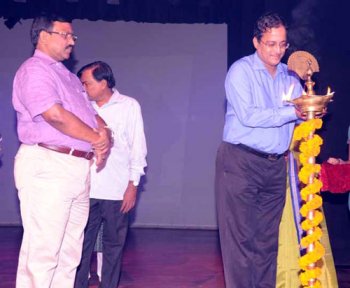 Mr. A.K. Tripathy lights the lamp
It is indeed very heartening to see that Contemporary dance has found a place in this series of festivals. Since East West Dance Encounter, which took place in January 1984 in Mumbai under the vision, guidance and sponsorship of Georg Lechner, the director of Max Mueller Bhavan, along with the National Centre for the Performing Arts (NCPA) and various other cultural agencies, within a span of thirty years Contemporary dance as a specific genre has come into its own. It would be also pertinent to mention that The Other Festival started by Anita Ratnam along with Ranvir Shah in Chennai also played a historical role, promoting Contemporary dance. Today in major cities like Mumbai, New Delhi, Chennai, Bangalore, Hyderabad and Kolkata, similar festivals and seminars have become a regular annual event. That Bhubaneswar has joined these cities is indeed a welcome gesture. All doubts regarding how the audiences exposed to classical dance forms and with Odissi becoming a dominant dance form like Bharatanatyam and Kathak, have been set to rest. The audiences in Bhubaneswar have shown willingness to watch Contemporary dances, as witnessed during the three evenings with Rabindra Mandap teeming with audiences. Indeed it is a matter of courage on part of the organizers to mount such a festival which is so different from routine fare of classical dances. The parameters are different. The entry points to what is being presented are not definite, nor has it a history of several years, so that the audiences have cultivated a taste for these arts. However, this is the only way to start a movement, to expose the audiences to innovative, experimental, what is often termed as 'modern' dance as opposed to classical dance, and provide an opportunity to bring within their experience work of artists who are creating dances which are very different from what one is used to watching. The term Samakala has been employed to suggest the 'contemporary-ness 'of dances which have different themes, where choreography, lighting, sets, costumes, music all play an important role. Many a time when audiences do not follow what is happening on the stage and are even at a loss as to what to make of these dances, how to respond to them, it is important to make a beginning somewhere. Even if there are no audiences coming in droves, to make a beginning is very important. All movements start in similar manner. Historically, 30 years is too small a time frame. But the very fact that young performers are training, performing and daring augurs well for Contemporary dance. 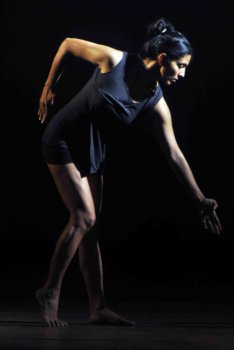 Padmini Chettur
Padmini covered the stage. The movements were slow, gaining momentum, she also used various levels, lying on floor, rolling on floor, rotating and vanishing. The body in her dance was stripped of unnecessary narrative and embellishments. The dancer wanted audiences to see body as the most important 'site' of 'our being.' She wished to convey such abstraction which indeed not all could relish or appreciate. Despite that with complete conviction, she performed with finesse irrespective of audience's varied response. M Natesan's lighting was excellent changing in a manner that often the dancer could be seen in a silhouette and at other times highlighting the contours of her body, whether she was on the floor or standing. The music by Maarten Visser, as mentioned earlier, was minimal. In contrast, Ashavari Majumdar, a Kathak exponent from Kolkata, in Surpanakha in an unusual treatment of the mythological character from the Ramayana, with considerable research, boldly used multi-media, projection of slides, images, with different texture, colours, image of ten headed Ravana, speaking to audiences as is often seen in Kathak, using several traditional elements, with excellent music by a set of musicians, with five trained young Kathak dancers, using mask, change of costumes, referring to dialogue between Surpanakha and Sita, Surpanakha's lust for Rama, using thumri sung melodiously 'Rasa ke bhare tore nain,' performing pirouettes, chakkars, using mnemonics of Kathak to suggest aggressive movements of Surpanakha, gentle dignity of Rama et al presented a complex production. 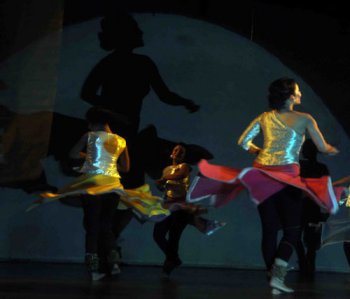
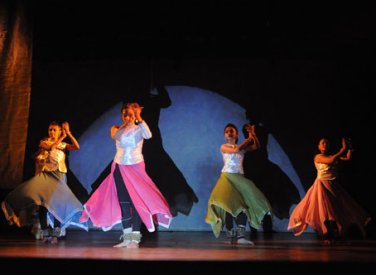
Ashavari Majumdar and group
There were too many elements which in this particular performance did
not coalesce and it became a mélange. I had seen earlier a solo
version of the production and many elements I could see jelled there,
which somehow did not in a group choreographic version. The humour was
lost and thereby the portrait of Surpanakha did not emerge as expected.
In solo version, the program ended with Rama stuti, which wisely
Ashavari had omitted in this version. But it looked as an abrupt end.
Her role as a sutradhari and the scope Kathak gives in speaking to
audience were explored to some success, but somehow this particular
presentation seemed bogged down under too many layers trying to speak of
several Surpanakhas - in a chaotic, non coherent manner, with a view to
present not one but many possible stories. Whereas one would compliment
Ashavari for her daring attempt, as one does not see in Kathak, barring
a few performers, choreographers venturing in this direction, it would
help Ashavari to have some sounding board of a dramaturge, so that the
production would hopefully restore its earlier impact. From New York, Uttara Asha Coorlawala, modern dancer, trained by Martha Graham and other modern dancers from USA and with training in Indian classical dance forms, currently teaching at Barnard College, Columbia University, is an awardee of Sangeet Natak Akademi for creative dance and a celebrated exponent, known as a pioneer in India for modern dance. She was visiting India and on learning about the Samakala festival she expressed her desire to witness the festival. Odisha Sangeet Natak Akademi invited her to give a lec- dem in the morning and share her experiences with participants and others. With help of power point presentation she explained her journey and spoke about early training at Martha Graham's academy. Entirely different from Indian classical dance training, Martha Graham's technique was different, though she had been influenced by Yoga. After receiving training in Modern dance, Uttara experimented using Yoga, Indian dance forms and the first work titled Yakshi was choreographed to music by Anand Shankar, son of Uday Shankar. She imagined movements after her visit to Konark when she had not seen Odissi. Odissi had at that time not received recognition as a classical dance form. She was inspired by watching large three dimensional human figures of dancers and musicians on the parapet of Konark temple when it was possible to climb up in those years and go near those sculptures. During East West Dance Encounter in January 1984 in Mumbai, she presented her choreographic work Winds of Shiva, using Bharatanatyam adavus and various Yoga exercises. She toured India with her company and drew attention of Indian dancers who were also working in isolation seeking new directions in Indian dance. She showed clippings of her work to western music and referred to works where she had used Indian Sanskrit prayers. Her trajectory of early 70s and 80s gave one an idea of how she was searching for contemporary dance. During the dialogue between Padmini Chettur and her, the present generation's explorations were explained as different from those of Uttara's. Ramli Ibrahim spoke in favour of Asian sensibilities for modern dance in place and dominance of Western modern dance. It was also considered necessary that more such seminars and explanations, dialogues should be held regularly so that the audience would be ready to appreciate contemporary dance. In the evening, Anita Ratnam from Chennai presented 'a triptych of dance panels on the Feminine.' Anita's work is an example of collaboration with choreographer, lights designer, musicians, costume designer and visual designer, bringing to the production complete professional approach, perfection and finesse. She also takes help of a dramaturg who advises her for an overall presentation. Therefore, the productions leave strong visual appeal. Of the three works, Sita was brief, using Bharatanatyam technique dwelling upon one phrase refusing to go from Sri Lanka on the shoulders of Hanuman, when Hanuman meets her in Ashokvana. The gestures, movements and abstractions further reinforced the determination of Sita remaining firm in her decision. The phrase Me, Go, Cross, Bow, Shoulders, No repeatedly were performed enhancing the refusal. 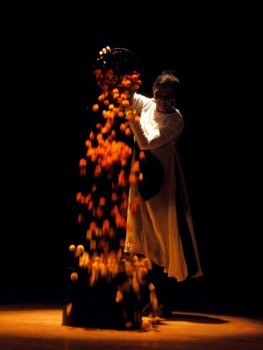
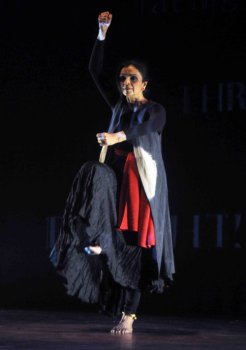
The brief excerpt 'Bashonti Meenakshi' from larger work 'Avani: a handful of dust' was based upon the work of Gurudev Rabindranath Tagore, when he had visited Kalakshetra in the thirties, and listened to Savitri Krishnan's "Meenakshi me mudum dehi" of Dikshitar and on return composed poetry to the same melody rendered in Rabindra Sangeet. Gurudev replaced Meenakshi into Basonti as an abstraction of the image of spring. Performing it in a sitting position, Anita used the hastas to describe the beauty of the spring and the spirit of the song doing justice to Dikshitar and Gurudev. It had haunting music both in Carnatic and Rabindra Sangeet renderings. Anita's most successful choreographic work was indeed Avani. The poem called Prithbi (meaning earth –Avani), is also woman's name. Gurudev speaks of earth in feminine tense. He describes her as 'unforgiving, relentless virago, always giving only to take back ferociously, nurturing and destroying'. Tagore compares her with female spider capable of giving birth but also eating her own children. Anita uses various dance vocabularies, including what she terms her own neo-bharatam, and employs improvisations, avoiding linear narrative. The poetry is fragmented like Tagore's thoughts and final solution is grim laced with a glimmer of hope. When Anita gets up and loosens her hair, moves ferociously, devouring children, moving further, with hand at the back destroying and marching forward, she succeeds in creating the grim picture. Anita has an arresting stage presence which helps her project the various shades of cruelty of earth. On the back, the poem was projected and had a touch of fragmentation. The lighting by Victor Paulraj succeeds in creating moods. With Vedanth Bharadwaj's guitar, Navin Iyer's flute and saxophone, and other musicians' input, the entire ensemble is superb. It helps the production in creating the right impact. Hari Krishnan's direction and co-choreography have helped the production in terms of communication. Anita and Hari Krishnan's collaboration has resulted in finished choreographic work. Astad Deboo presented four works of which the second one with larger than life size puppets of mother Kali was outstanding and stunning. In its scale and colour, visuals, music, dancing by the Salam Balak Trust artists who performed Mayurbhanj Chhau technique before the huge images in a flawless manner, the concept, its execution and the lighting were stunning. Astad's imagination takes one by complete surprise. I had seen this work in New Delhi and it had left an indelible impression. Viewing it second time it reinforced its impact. The prayer, touching the feet of the Goddess, the Goddess blessing the devotees, placing arms on head of the bhakta, and the bhakta looking diminutive - the visual illusion is achieved like a miracle. The first piece with young artists whom Astad is training impresses one with their ability to grasp and imbibe the technique. The balancing of the body, the various slow movements and formations, with artistic lighting, simple costumes achieve desired effect. 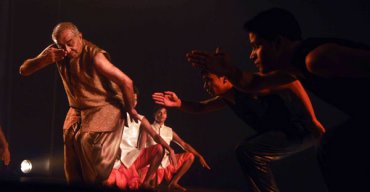
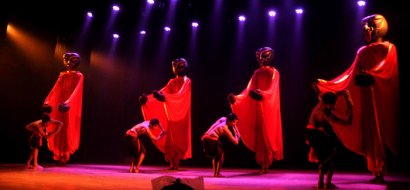
When some of us interviewed Astad next day, he told us Tagore's "Ekla chalo" is semi autobiographical. Till then it had not struck us like it. Tagore's most famous poem gives one hope to continue working alone, even when no one joins one in the struggle. Astad has used the young artists as forces which are helpful and also as which could create hurdles in one's journey, but not losing hope, the protagonist continues. Astad's choreographic work in which like a Sufi dervish he moves in rounds inspired from Kathak pirouettes to fascinating music astounds one and all for sheer capacity Astad has to move with tremendous concentration and maintain balance. The white long costume captures the momentum with music and colorful lighting mesmerizing the audience. Astad invariably receives standing ovation, which he richly deserves as one respects his journey which he continues against all odds. Astad did get angry because he felt the photographers flashed light disturbing him. In India press photographers work in this manner only and no solution has been found. I would suggest that Astad request photographers in a more amiable manner which would help him and also photographers. The relation between the artist and the photographers /press has to be on a cordial level. I am sure an artist of his stature would win them over. On the final evening, Navtej Johar and Sandeep Kumar presented Dravya Kaya in its complete avatar. I had seen this work in part at Natya Kala Conference in Chennai few years ago at Sri Krishna Gana Sabha. The work focuses upon select objects found in Ramayana and attempts to view the epic through the perspective of these neutral objects. Both the dancers' bodies as it were appeared like taut Kodanda bow of Rama. The continuous gazing at each other and turning bodies in various shapes was fascinating. Sita's Valkala garment was turned by Navtej as a bunch of newspapers in terms of a skirt for Sita, when banished into the forest to wear as garment. It was suggestive of relationship between Sita and earth. Through the episode of Lakshmana Rekha, Navtej seemed to be making a comment upon the status of Rama. 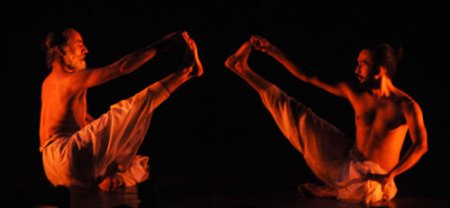
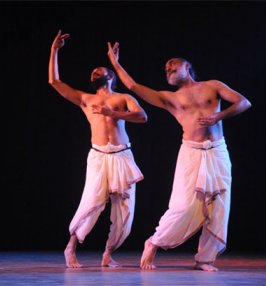
Navtej has introduced a character at the end, who is commenting upon Ramayana, the present state of chaos in the world. Holding a mike and speaking into it, reflecting upon various aspects of present day life, as a critique, part political, part humorous, part incongruent, and ends the work with the speaker in total happiness, being with Rama. Navtej has indeed choreographed the work with diligence and deep thought, concern for what he feels is happening all around us. However, the end left one wondering at its treatment. At times it looked like the character was, with readings from Kabir, Nanak, preaching, to display anguish, and seeking calm within. I am not sure how to respond to it. Maybe it needs reworking to make it sound cohesive. Both the dancers performed with intensity and with their excellent command over their bodies, the discipline of classical Bharatanatyam technique. The music by G. Elangovan and lighting by Nitin Jain enhanced the beauty if the production. The finale was from Kuala Lumpur, by Malaysian Odissi exponent Ramli Ibrahim. Known for his choreography be it group or solo, Ramli brings to bear upon his works a fresh perspective drawing inspiration from the traditional dance forms Bharatanatyam and Odissi and from Western dance forms classical ballet and modern dance. Titled Transfigurations, the Riversutra consisting of the clusters of five contemporary works, Ramli presented a homage to Ganapati, his dancers moving forward, one turning into his vehicle Mushaka, others following waving arms, flapping ears, third moving one arm suggesting trunk and others standing behind turning the iconic image using arms to depict the multi-armed God with elephant's head. 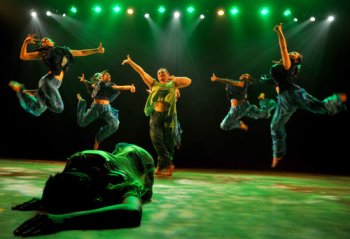
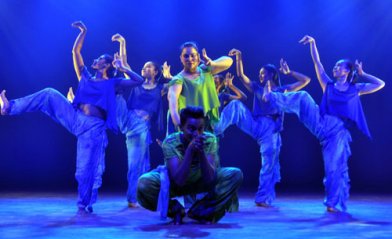
"Pibare Rama rasam" to the music by Karthik (Music I like) in praise of Lord Rama followed by Kamala, imaginatively choreographed, explores the concept of devotion and piety inspired by eastern and western mythic images related to Mother Goddess, the Madonna and Shakti. These manifestations with the rose and the lotus represent metaphors of auspiciousness, beauty and grace. The complimentary male principle, the images of Purusha, Shiva and Jesus is well incorporated in this number. Ramli uses dancers standing in a row to create images of multi- armed goddesses, and the circular movement of arms gives it dynamism, bringing to life the Tantric visions. Juxtaposing Kamala, Madonna, using, slokas and Gregorian chant, he creates soundscapes with dancers performing sometimes in a frenzy and at times peacefully. Dressed in white with pink borders, with lighting by Sivarajah Natarajan, who paints the sequences with sensitivity and a sense of colours, the visuals haunt one. In Ramli's choreography, I notice his way of covering space, dancers holding arms, entwined, running from one direction to another, completing a circle and he also uses human pyramid, dancers climbing on the top and one is reminded of Gotipua dancers, Bandha elements used in a novel manner. The confluence of music by Tania, Aruna Sairam, Dominique Vellard and Bombay Jayshree is dovetailed with understanding and the quality of music stands out. In 2005, Ramli recalled that he had presented Nijinsky's 'Apre Midi une Faune' (One afternoon of Faun) choreographing it upon Odissi dancer Rahul Acharya. In the present version, he revisits the work on Sutra's young dancer Harenthiran as the Faun to the music by Debussy. The mythical creature half-goat and half-human with his walk in profile, enticed by the nymphs and in a design of lighting like a canopy, the dancers moving under it created fascinating visuals. The scarf picked up by Faun, floats lightly and the nymphs disappear. Faun clings to the scarf lying on the floor with an erotic image. I have seen Ramli playing the role of Faun, and last year Faun by Sean Scantlebury of Jonathan Hollander's Battery Dance Company. Inspired by the athleticism and sensuality of the dancer, Ramli had displayed his varied approach to the choreography of this work. In this version, Harenthiran's dark body and tense movements were noteworthy. Using nritta in Odissi sthai to the nritta based upon Gajendra Panda's and music by Lakshmikant Palit, Ramli had choreographed Sthai to present joyous mood of Vasanta, spring. To the restructured music, the dancers performed with abandon investing the number with freshness. In "Krishna nee begane baro," there was playfulness, mother Yashoda's love for baby Krishna, wonder at looking into his mouth when he ate the earth and seeing the universe, and so on with dancers playing all around, the music had a feel of mother's love for her child. Tillana based on the original choreography by Adyar Lakshman and to the music by Adyar Lakshman, Thomas Nawarati, George Graf, Gerhard Rosener and Baba Prasad, saw dancers competing with each other and finally reconciling and performing in a group. Ramli succeeded in 'engaging the audience to celebrate the traditional in the modern and the modern in the classical.' Sutra Collective consisting of Ramli, Rathimalar Govindarajoo, Nisha Devi, Divya Nair succeeded in presenting these group compositions in a contemporary manner, using specially designed costumes and melodious music. Among the performers, the senior dancers like Rathimalar Govindarajoo merged well with young ones like Tan Mei Mei, Geethika Sree, Divya Nair, Harenhiran and Nalina Nair. Ramli trains a young generation of dancers with his by now well known methodology, paying attention to minor details and movements which synchronize perfectly with his concepts of choreography. Add to it the exquisite lighting by Sivarajah Natarajan and Ramli's Sutra presentations as always stand out for its professionalism and high quality of dancing. This 2nd edition of Samakala Festival of contemporary choreography proved that the audiences are willing to see what is new in Indian dance, whether they can immediately appreciate these works or not. The very fact that Odisha welcomes these trends in Indian dance scene augurs well for indigenous contemporary Indian dance. Aruna Mohanty, Vice President of Odisha Sangeet Natak Akademi, secretary Chittaranjan Mallia, the entire team of artists and backstage workers along with support from Tourism Department, Govt. of Odisha, have provided a role model for other states to follow. The vibrant dance scene of Odisha has proved that dancers are willing to perform during such a well planned festival. What is heartening is that the necessary components for lighting and sound which now form necessary components of contemporary dance are provided by the Tourism Dept with an auditorium with better facilities, which make such festivals memorable.  Dr. Sunil Kothari is a dance historian, scholar, author and a renowned dance critic. He is Vice President of World Dance Alliance Asia Pacific India chapter, based in New Delhi. He is honored by the President of India with Padma Shri, Sangeet Natak Akademi award and Senior Critic Award from Dance Critics Association, NYC. He is a regular contributor to www.narthaki.com, the roving critic for monthly magazine Sruti and is a contributing editor of Nartanam for the past 12 years. Post your comments Pl provide your name and email id along with your comment. All appropriate comments posted with name and email id in the blog will also be featured in the site. |